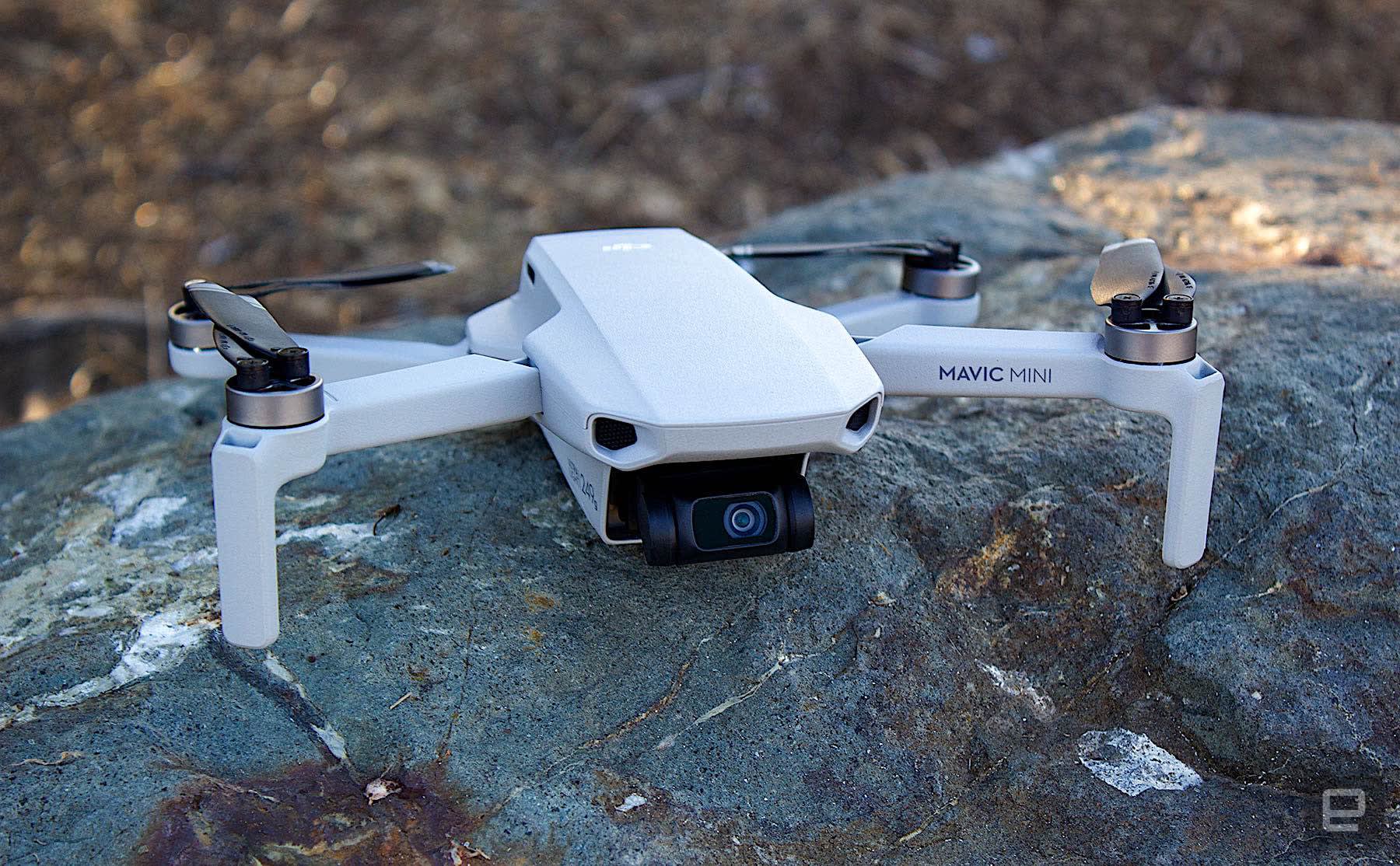The Mavic Mini is so small and light (just 249g) you won’t need to register it with the FAA — you were registering your larger drones with the FAA, right? But that size isn’t just about doing less paperwork, it’s about doing more flying. With a drone you can literally slip in your back pocket, there’s almost never an inconvenient time to bring along, assuming you have a second pocket for the controller. (You can’t fly the Mini with just your phone like you could the Spark.)
DJI has traditionally been good about giving its smaller/cheaper drones premium features. The Air, for example, cost less than the Mavic Pro that came before it, but it had features its pricier sibling didn’t. Even the little old Spark offered gesture control and follow-me features on a budget. With the Mini, though, there are quite a few compromises — but the majority shouldn’t deter most people.
Perhaps the most crucial missing feature is obstacle avoidance. The Mavic 2 Pro and the Air both come with sensors that detect obstacles, allowing for safer flying. The Mavic Mini has none. This seems reasonable given that the Mini costs more than $1,300 less than the Mavic Pro 2 and $500 less than the Air. But DJI is also pitching the Mini at beginners who would benefit from those sensors the most.
The second notable compromise is the camera. As with the Spark, there’s no 4K video here but the Mini will record in 2.7K/30 (along with FHD up to 60 fps at 40Mbps), so there’s at least some form of high resolution to enjoy. Another trick the Mini has that the Spark doesn’t is the ability to fold down its arms. The Spark’s body is a similar size, but its fixed arms make it much less portable.
The Mavic line’s foldable design has become something of a calling card. What makes drones unwieldy are those all-important protruding arms. DJI came up with a clever design for the first Mavic, and it’s been present in nearly all its consumer drones since. When fully folded down, the Mini is about the size of a soda can and weighs about as much as a large phone (my OnePlus 7 Pro with a case comes in at around 230g).
When I first saw the Mini I had some concerns. Mostly, how will it hold up in windy conditions? The bigger Mavics easily hold their position against strong breezes. The Mini actually does surprisingly well here too. I really thought it would be thrown around, but it held its ground (at least against the gusty Bay Area coast). I did notice it would often move up and down with the wind, but lateral movement was minimal.
In fact, the app was warning me that conditions were too windy and to fly with caution, but the video held steady. You can see the Mini twitching in the air, but it won’t spoil your footage. If anything, it’s the vertical position that’s more troubling. I flew out in a straight line over water, and a few times I had to pull the drone up because the wind was pushing it down.
The Mavic Mini might lack obstacle-avoidance sensors, but it’s not completely devoid of positioning technology. There’s GPS, obviously, and a downward-facing sensor so that it can hold its position when there’s no satellite connection (for example, indoors).
I was also surprised that the Mavic Mini doesn’t offer “Tripod mode.” This simple feature found in other Mavics limits the speed of a drone, which in combination with the three-axis gimbal is great for slow, steady tracking shots. The Mini would be perfect for this, especially when flying indoors. As far as I can tell, there’s no technical reason the Mini doesn’t support it, but it’s not here, which is a slight disappointment. There is, however, a new “Cinesmooth” mode, which DJI says “elongates the braking process.” That sounds a bit dull, but in my testing, it actually is more like Tripod mode (thankfully) than I thought. Basically, it seems to soften out turns, braking and other harsh movements, leaving you with a much smoother shot.
It’s also worth noting that you have to change flying modes (Regular/Sport and Cinesmooth) in the app now. Other Mavics have a switch on the controller, but that’s another small compromise I guess. In fact, the whole app experience is massively simplified. I’m inclined to say that this is a good thing, as I’ve never been a huge fan of DJI’s information-dense app. But as nice as it is to have things simplified, I’d almost say the new Go app is almost too sparse. It’s nice that there are fewer things onscreen, but vital information like battery life and GPS signal is represented by icons so small that you can’t really see them at a glance — which means you end up peering at the screen for longer than you’d like.
In its attempt to simplify, DJI also moved the QuickShot section of the app under the camera options on the right, rather than over on the left under its own icon as before. Here you can choose between photo, video and QuickShot. The sub-menu for each will appear once you select it.
For photos, you’ll only see the self-explanatory options for “Single” or “Timed shot,” though under the main settings menu, you’ll find options for photo aspect ratio (4:3 or 16:9), toggles for the onscreen histogram and overexposure warning, gridlines and so on. As already mentioned, for video, your options are FHD and 2.7K, and then a choice of frame rates: 25, 30, 50 and 60 for FHD versus 25 and 30 for 2.7K. No 24 fps here for some reason.
The selection of QuickShots on the Mini is limited. You have Dronie, Rocket, Circle and Helix — the names broadly describe how the Mini will move around a target. There’s no Asteroid or Boomerang this time around, and that’s fine. I’m more disappointed at the lack of ActiveTrack — DJI’s people-tracking feature. It’s been present on most products, including the Osmo Mobile, which doesn’t have a camera at all (it uses your phone’s). What’s curious is that the QuickShot modes the Mini does have ask you to click on a human target for it to focus on — so the bones of the technology are there, but for some reason the company chose not to include it. Long story short, the Mavic Mini can’t follow you autonomously. But it feels like something that’s just a firmware update away.
Despite the minor annoyances, like the small power indicator (it’s literally a small battery icon with a percentage number like on a phone), the app is easy to use. Connect your phone to the controller, open the app and you’re pretty much good to go. The bigger problem is that the connection with the drone is done over WiFi, which doesn’t handle the video stream nearly as well as DJI’s proprietary Ocusync technology. For the most part, it’s fine, but there were too many times when the stream stalled or skipped. This was particularly frustrating when I was relying on that connection to line up and monitor my shot.
A related issue, not unique to the Mini but exacerbated by its size, is that it’s remarkably easy to lose sight of the drone in the sky after you’ve looked down at the video stream. Line-of-sight flying is important. I see too many people flying with the drone out of view, relying on the video stream to know where it is. But that video stream can fail, and it did with the Mavic Mini just enough that I would never rely on it for navigation. Even just a quick glance at the app, look back up and… where the hell did it go? It caught me out a few times.
You don’t need your phone at all to fly the drone, or even to shoot video. But it’s much easier with the video stream and on-screen buttons should you need to take action and maneuver around something. Also, while there are buttons on the controller to take a photo or start a video, you can’t change settings or access QuickShots, so you definitely want your phone fully charged.
Not least, because the Mini can fly for a long time. DJI claims up to 30 minutes per charge. I think that’s possible if you fly gently, but around 25 minutes is more realistic in windy conditions, or if you’re tearing around in Sport mode etcetera.
A few more minor nitpicks, and we’ll get to the good stuff, I promise. The first one is that there’s no way to see how much charge the Mini’s batteries have, unless they’re either in the drone or in the multi-charging caddy (which comes with the “Fly more” kit). Most other camera drones have a button on the batteries that will show roughly how much power they have left. Having to put a battery in the drone or the caddy isn’t exactly hard, but if you have a few of them, it’s not ideal.
Secondly, it’s 2019, and everything on the Mavic Mini is still micro-USB. To charge the controller? Micro-USB. Want to connect to the drone itself? You get it. USB-C has been around long enough that it should be the default here. Especially on the battery charging caddy. Using micro-USB just means charging takes longer. (Oh, bonus nitpick: The caddy holds three batteries, but charges them one by one, not in parallel, which seems a little unhelpful.) And lastly, for the first time in a few years, I managed to get the propellers in shot. This used to be a regular problem, until DJI figured out how to keep them out of the camera’s way. It’s only happened once so far, in windy conditions and during a tight turn, but worth remembering that it can happen.






